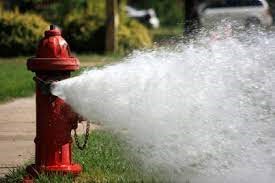Spring Hydrant Flushing
Spring Hydrant Flushing
Fire hydrant flushing is performed to remove any sediment or stagnant water form the distribution system and to test fire hydrant operation. These steps are taken to improve the overall water quality within the distribution system and to ensure the delivery of the highest quality of water possible. As in the past, the water may become temporarily discolored and residents should avoid washing clothes while flushing is in progress in your area.
Important Information about your Drinking Water
Our water system will soon being fire hydrant flushing that may affect the lead content of your potable water supply. Lead, a metal found in natural deposits, is harmfull to human health. The most common exposure to lead is swallowing or breathing in lead paint chips and dust. However, lead in drinking water can also be a source of lead exposure. In the past, lead was used in some water service lines and household plumbing materials. Lead in water usually occurs through corrosion of plumbing products containing lead: however, disruption (construction or maintenance) of lead service lines may also temporarily increase lead levels in the water supply. This disruption may sometimes be caused by disturbances in the water sytem from hydrant flushing.
Beginning June 19, 1986, new or replace water service lines and new household plumbing materials could not contain more than 8% lead. In addition, Juanry 4, 2014, lead content was further reduced requiring plumbing materials to now be certified as "lead-free" (weighted average of the wetted surface cannon be more than 0.25% lead).
The purpose of this notice is for informational only. While it is not known for certain whether or not flushing of the water system will adversely affect the lead (if present) plumbing in and outside your home, below describes some information about the project and some preventatvie measures you can take to help reduce the amount of lead in drinking water.
Project location and description:
The entire water system for the town will be flushed.
What you can do to reduce lead exposure in drinking water during hydrant flushing: run your water to flush out lead. If the plumbing in your home is accessible; you may be able to inspect your own plumbing to determin whether or not you have a lead service line. Otherwise, you will most likley need to hire a plumber.
- If you not have a lead service line, running the water for 1-2 minutes at the kitchen tap shoud clear the lead from your household plumbing to the kitchen tap. Once you have done this, fill a container with water and store it in the refrigerator for drinking, cooking, and preparing baby formula throughout the day.
- If you do have lead service line, flushing times can vary based on the length of your service line and plumbing configuration in your home. The length of lead service lines varies considerably. Flushing for at least 3-5 minutes is reommended.
Use cold water for drinking, cooking, and preparing baby formula. Do not cook with or drink water from hot water tap. Lead dissolves more easily in hot water. Do not use water from hot water tap to make baby formula.
Look for alternative sources or treatment of water. You may want to consider purchasing bottle water or a wtaer filter that is certified to remove total lead.
Clean and remove any debris from faucet aerators on a regular basis.
Do not boil water to remove lead. Boing water will not reduce lead.
Purchase lead-free faucets and plumbing components.
Remove the entire lead service line.


